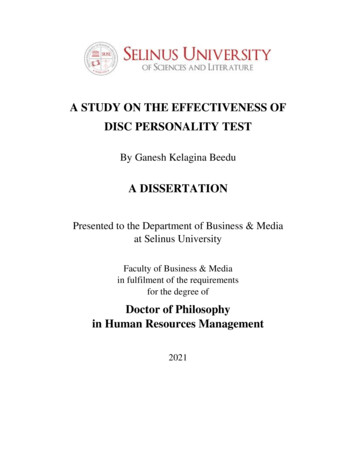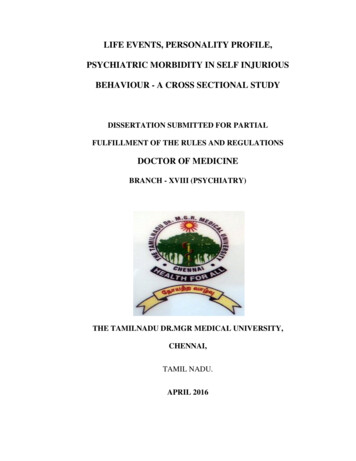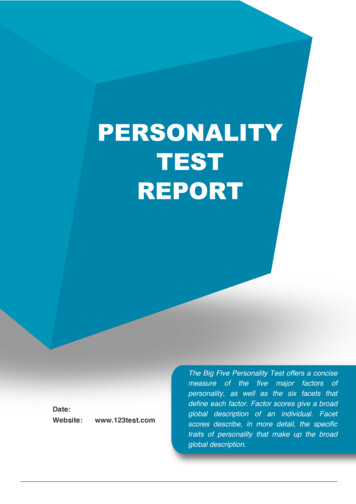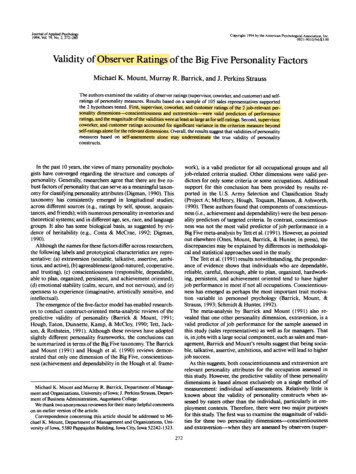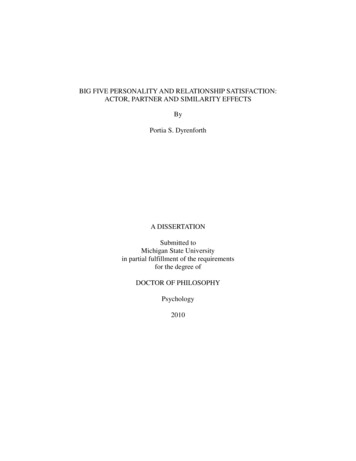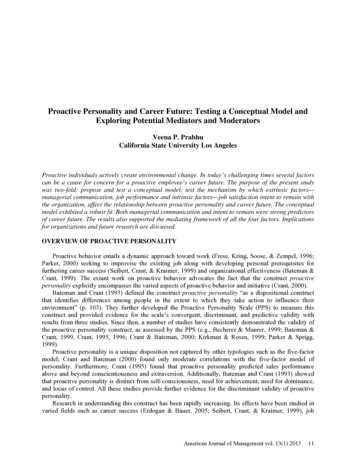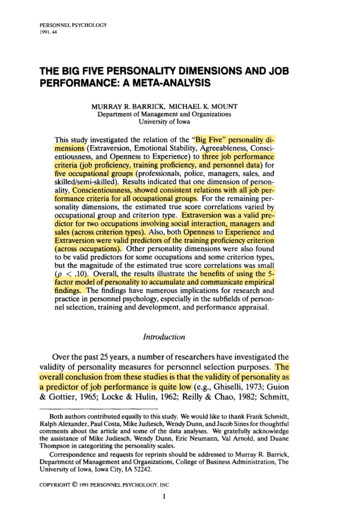
Transcription
PERSONNEL PSYCHOLOGY1991,44THE BIG FIVE PERSONALITY DIMENSIONS AND JOBPERFORMANCE: A META-ANALYSISMURRAY R. BARRICK, MICHAEL K. MOUNTDepartment of Management and OrganizationsUniversity of IowaThis study investigated the relation of the "Big Five" personality dimensions (Extraversion, Emotional Stability, Agreeableness, Conscientiousness, and Openness to Experience) to three job performancecriteria (job proficiency, training proficiency, and personnel data) forfive occupational groups (professionals, police, managers, sales, andskilled/semi-skilled). Results indicated that one dimension of personality. Conscientiousness, showed consistent relations with all job performance criteria for all occupational groups. For the remaining personality dimensions, the estimated true score correlations varied byoccupational group and criterion type. Extraversion was a valid predictor for two occupations involving social interaction, managers andsales (across criterion types). Also, both Openness to Experience andExtraversion were valid predictors of the training proficiency criterion(across occupations). Other personality dimensions were also foundto be valid predictors for some occupations and some criterion types,but the magnitude of the estimated true score correlations was small(p .10). Overall, the results illustrate the benefits of using the 5factor model of personality to accumulate and communicate empiricalfindings. The findings have numerous implications for research andpractice in personnel psychology, especially in the subfields of personnel selection, training and development, and performance appraisal.IntroductionOver the past 25 years, a number of researchers have investigated thevalidity of personality measures for personnel selection purposes. Theoverall conclusion from these studies is that the validity of personality asa predictor of job performance is quite low (e.g., Ghiselli, 1973; Guion& Gottier, 1965; Locke & Hulin, 1962; Reilly & Chao, 1982; Schmitt,Both authors contributed equally to this study. We would like to thank Frank Schmidt,Ralph Alexander, Paul Costa, Mike Judiesch, Wendy Dunn, and Jacob Sines for thoughtfulcomments about the article and some of the data analyses. We gratefully acknowledgethe assistance of Mike Judiesch, Wendy Dunn, Eric Neumann, Val Arnold, and DuaneThompson in categorizing the personality scales.Correspondence and requests for reprints should be addressed to Murray R. Barrick,Department of Management and Organizations, College of Business Administration, TheUniversity of Iowa, Iowa City, IA 52242.COPYRIGHT 1991 PERSONNEL PSYCHOLOGY. INC1
2PERSONNEL PSYCHOLOGYGooding, Noe, & Kirsch, 1984). However, at the time these studies wereconducted, no well-accepted taxonomy existed for classifying personalitytraits. Consequently, it was not possible to determine whether therewere consistent, meaningful relationships between particular personalityconstructs and performance criteria in different occupations.In the past 10 years, the views of many personalify psychologists haveconverged regarding the structure and concepts of personalify. Generally, researchers agree that there are five robust factors of personalify(described below) which can serve as a meaningful taxonomy for classifying personalify attributes (Digman, 1990). Our purpose in the presentstudy is to examine the relationship of these five personalify constructsto job performance measures for different occupations, rather than tofocus on the overall validify of personalify as previous researchers havedone.Emergence of the 5-Factor ModelSystematic efforts to organize the taxonomy of personalify beganshortly after McDougall (1932) wrote that, "Personalify may to advantage be broadly analyzed into five distinguishable but separate factors,namely intellect, character, temperament, disposition, and temper."(p. 15). About 10 years later, Cattell (1943, 1946, 1947, 1948) developed a relatively complex taxonomy of individual differences that consisted of 16 primary factors and 8 second-order factors. However, repeated attempts by researchers to replicate his work were unsuccessful(Fiske, 1949; Tupes, 1957; Tupes & Christal, 1961) and, in each case,researchers found that the 5-factor model accounted for the data quitewell. For example, Tupes and Christal (1961) reanalyzed the correlationsreported by Cattell and Fiske and found that there was good support forfive factors: Surgency, Emotional Stabilify, Agreeableness, Dependabilify, and Culture. As it would turn out later, these factors (and those ofMcDougall 35 years before) were remarkably similar to those generallyaccepted by researchers today. However, as Digman (1990) points out,the work of Tupes and Christal had only a minor impact because theirstudy was published in an obscure Air Force technical report. The 5factor model obtained by Fiske (1949) and Tupes and Christal (1961)was corroborated in four subsequent studies (Borgatta, 1964; Hakel,1974; Norman, 1963; Smith 1967). Borgatta's findings are noteworthybecause he obtainedfivestable factors acrossfivemethods of data gathering. Norman's work is especially significant because his labels (Extraversion. Emotional Stabilify, Agreeableness, Conscientiousness, andCulture) are used commonly in the literature and have been referred to,subsequently, as "Norman's Big Five" or simply as the "Big Five."
BARRICK AND MOUNT3During the past decade, an impressive body of literature has accumulated which provides compelling evidence for the robustness of the 5factor model: across different theoretical frameworks (Goldberg, 1981);using different instruments (e.g., Conley, 1985; Costa & McCrae, 1988;Lorr & Youniss, 1973; McCrae, 1989; McCrae & Costa, 1985, 1987,1989); in different cultures (e.g. Bond, Nakazato, & Shiraishi, 1975;Noller, Law, & Comrey, 1987); using ratings obtained from differentsources (e.g., Digman & Inouye, 1986; Digman & Takemoto-Chock,1981; Fiske, 1949; McCrae & Costa, 1987; Norman, 1963; Norman &Goldberg, 1966; Watson, 1989); and with a variety of samples (see Digman, 1990, for a more detailed discussion). An important considerationfor the field of personnel psychology is that these dimensions are also relatively independent of measures of cognitive ability (McCrae & Costa,1987).It should be pointed out that some researchers have reservationsabout the 5-factor model, particularly the imprecise specification ofthese dimensions (Briggs, 1989; John, 1989; Livneh & Livneh, 1989;Waller & Ben-Porath, 1987). Some researchers suggest that more thanfive dimensions are needed to encompass the domain of personality. Forexample, Hogan (1986) advocates six dimensions (Sociability, Ambition,Adjustment, Likability, Prudence, and Intellectance). The principle difference seems to be the splitting of the Extraversion dimension into Sociability and Ambition.Interpretations of the "Big Five"While there is general agreement among researchers concerning thenumber of factors, there is some disagreement about their precise meaning, particularly Norman's Conscientiousness and Culture factors. Ofcourse, some variation from study to study is to be expected with factorsas broad and inclusive as the 5-factor model. As shown below, however,there is a great deal of commonality in the traits that define each factor,even though the name attached to the factor differs.It is widely agreed that the first dimension is Eysenck's Extraversion/Intraversion. Most frequently this dimension has been called Extraversion or Surgency (Botwin & Buss, 1989; Digman & TakemotoChock, 1981; Hakel, 1974; Hogan, 1983; Howarth, 1976; John, 1989;Krug & Johns, 1986; McCrae & Costa, 1985; Noller et al., 1987; Norman, 1963; Smith, 1967). Traits frequently associated with it include being sociable, gregarious, assertive, talkative, and active. As mentionedabove, Hogan (1986) interprets this dimension as consisting of two components. Ambition (initiative, surgency, ambition, and impetuous) andSociability (sociable, exhibitionist, and expressive).
4PERSONNEL PSYCHOLOGYThere is also general agreement about the second dimension. Thisfactor has been most frequently called Emotional Stability, Stability,Emotionality, or Neuroticism (Borgatta, 1964; Conley, 1985; Hakel,1974; John, 1989; Lorr & Manning, 1978; McCrae & Costa, 1985; Nolleret al., 1987; Norman, 1963; Smith, 1967). Common traits associated withthis factor include being anxious, depressed, angry, embarrassed, emotional, worried, and insecure. These two dimensions (Extraversion andEmotional Stability) represent the "Big Two" described by Eysenck over40 years ago.The third dimension has generally been interpreted as Agreeableness or Likability (Borgatta, 1964; Conley, 1985; Goldberg, 1981; Hakel,1974; Hogan, 1983; John, 1989; McCrae & Costa, 1985; Noller et al.,1987; Norman, 1963; Smith, 1967; Tupes & Christal, 1961). Others havelabeled it Friendliness (Guilford & Zimmerman, 1949), Social Conformity (Fiske, 1949), Compliance versus Hostile Non-Compliance (Digman & Thkemoto-Chock, 1981), or Love (Peabody & Goldberg, 1989).Traits associated with this dimension include being courteous, flexible,trusting, good-natured, cooperative, forgiving, soft-hearted, and tolerant.The fourth dimension has most frequently been called Conscientiousness or Conscience (Botwin & Buss, 1989; Hakel, 1974; John, 1989;McCrae & Costa, 1985; Noller et al., 1987; Norman, 1963;), although ithas also been called Conformity or Dependability (Fiske, 1949; Hogan,1983). Because of its relationship to a variety of educational achievement measures and its association with volition, it has also been calledWill to Achieve or Will (Digman, 1989; Smith, 1967; Wiggins, Blackburn, & Hackman, 1969), and Work (Peabody & Goldberg, 1989). Asthe disparity in labels suggests, there is some disagreement regarding theessence of this dimension. Some writers (Botwin & Buss, 1989; Fiske,1949; Hogan, 1983; John, 1989; Noller et al., 1987) have suggested thatConscientiousness reflects dependability; that is, being careful, thorough, responsible, organized, and planful. Others have suggested thatin addition to these traits, it incorporates volitional variables, such ashardworking, achievement-oriented, and persevering. Based on the evidence cited by Digman (1990), the preponderance of evidence supportsthe definition of conscientiousness as including these volitional aspects(Bernstein, Garbin, & McClellan, 1983; Borgatta, 1964; Conley, 1985;Costa & McCrae, 1988; Digman & Inouye, 1986; Digman & TakemotoChock, 1981; Howarth, 1976; Krug & Johns, 1986; Lei & Skinner, 1982;Lorr & Manning, 1978; McCrae & Costa, 1985, 1987, 1989; Norman,1963; Peabody & Goldberg, 1989; Smith, 1967).The last dimension has been the most difficult to identify. It has beeninterpreted most frequently as Intellect or Intellectence (Borgatta, 1964;
BARRICK AND MOUNT5Digman & Takemoto-Chock, 1981; Hogan, 1983; John, 1989; Peabodyand Goldberg, 1989). It has also been called Openness to Experience(McCrae & Costa, 1985) or Culture (Hakel, 1974; Norman, 1963). Digman (1990) points out that it is most likely all of these. Itaits commonlyassociated with this dimension include being imaginative, cultured, curious, original, broad-minded, intelligent, and artistically sensitive.The emergence of the 5-factor model has important implications forthe field of personnel psychology. It illustrates that personality consistsof five relatively independent dimensions which provide a meaningfultaxonomy for studying individual differences. In anyfieldof science, theavailability of such an orderly classification scheme is essential for thecommunication and accumulation of empirical findings. For purposesof this study, we adopted names and definitions similar to those usedby Digman (1990): Extraversion, Emotional Stability, Agreeableness,Conscientiousness, and Openness to Experience.Expected Relations Between PersonaUty Dimensions and Job PerformanceIn the present study, we investigate the validity of the five dimensions of personality for five occupational groups (professionals, police,managers, sales, and skilled/semi-skilled) and for three types of job performance criteria (job proficiency, training proficiency, and personneldata) using meta-analytic methods. We also investigate the validity ofthefivepersonality dimensions for objective versus subjective criteria.We hypothesize that two of the dimensions of personality. Conscientiousness and Emotional Stability, will be valid predictors of all jobperformance criteria for all jobs. Conscientiousness is expected to berelated to job performance because it assesses personal characteristicssuch as persistent, planful, careful, responsible, and hardworking, whichare important attributes for accomplishing work tasks in all jobs. Thereis some evidence that in educational settings there are consistent correlations between scores on this dimension and educational achievement (Digman & Takemoto-Chock, 1981; Smith, 1967). Thus, we expect that the validity of this dimension will generalize across all occupational groups and criterion categories. We also expect that the validityof Emotional Stability will generalize across occupations and criteriontypes. Viewing this dimension from its negative pole, we expect that employees exhibiting neurotic characteristics, such as worry, nervousness,temperamentalness, high-strungness, and self-pity, will tend to be lesssuccessful than more emotionally stable individuals in all occupationsstudied because these traits tend to inhibit rather than facilitate the accomplishment of work tasks.
6PERSONNEL PSYCHOLOGYWe expect that other personality dimensions may be related to jobperformance, but only for some occupations or some criteria. For example, in those occupations that involve frequent interaction or cooperation with others, we expect that two personality dimensions, Extraversion and Agreeableness, will be valid predictors. These two dimensionsshould be predictive of performance criteria for occupations such asmanagement and sales, but would not be expected to be valid predictors for occupations such as production worker or engineer.In a similar vein, we expect that Openness to Experience will be avalid predictor of one of the performance criteria, training proficiency.This dimension is expected to be related to training proficiency because itassesses personal characteristics such as curious, broadminded, cultured,and intelligent, which are attributes associated with positive attitudestoward learning experiences. We believe that such individuals are morelikely to be motivated to learn upon entry into the training program and,consequently, are more likely to benefit from the training.Finally, we investigated a research question of general interest to personnel psychologists for which we are not testing a specific hypothesis.The question is whether the validity coefficients for the five personalitydimensions diflfer for two types of criteria, objective and subjective. Arecent meta-analysis by Nathan and Alexander (1988) indicates that, ingeneral, there is no difference between the magnitude of the validitiesfor cognitive ability tests obtained for objective and subjective criteria forclerical jobs. In another study, Schmitt et al. (1984) investigated the validity of personality measures (across dimensions and occupations) fordifferent types of criteria, but no definitive conclusions were apparentfrom the data. The average validity for the subjective criterion (performance ratings) was .206. Validities for three of four objective criteriawere lower (.121 for turnover, .152 for achievement/grades, and .126 forstatus change), whereas the validity was higher for wages (.268). Thus,conclusions regarding whether the validities for personality measures arehigher for objective, compared to subjective, criteria depend to a largeextent on which objective measures are used. Because our study examines personality using a 5-factor model, we are able to assess whetherdimensions have differential relationships to various objective and subjective criteria.In summary, the following hypotheses will be tested in this study.Of thefivedimensions of personality. Conscientiousness and EmotionalStability are expected to be valid predictors of job performance for alljobs and all criteria because Conscientiousness measures those personalcharacteristics that are important for accomplishing work tasks in alljobs, while Emotional Stability (when viewed from the negative pole)measures those characteristics that may hinder successful performance.
BARRICK AND MOUNT7In contrast, Extraversion and Agreeableness are expected to correlatewith job performance for two occupations, sales and management, because interpersonal dispositions are likely to be important determinantsof success in those occupations. Finally, Openness to Experience is expected to correlate with one of the criterion types, training proficiency,because Openness to Experience appears to assess individuals' readinessto participate in learning experiences. In addition, we investigated thevalidity of various objective and subjective criteria for thefivepersonalitydimensions.MethodLiterature ReviewA literature search was conducted to identify published and unpublished criterion-related validity studies of personality for selection purposes between 1952 and 1988. Three strategies were used to searchthe relevant literature. First, a computer search was done of PsycINFO(1967-1988) and Dissertation Abstracts (1952-1988) in order to find allreferences to personality in occupational selection. Second, a manualsearch was conducted that consisted of checking the sources cited in thereference section of literature reviews, articles, and books on this topic,as well as personality inventory manuals, Buros Tests in Print (volumes 49,1953-1985), and journals that may have included such articles (including the Journal of Applied Psychology, Personnel Psychology, Academy ofManagement Journal, Organizational Behavior and Human Decision Processes/Organizational Behavior and Human Performance, Journal of Management, Journal of Vocational Behavior, Journal of Personality and SocialPsychology, Journal of Personality, and Journal of Consulting and ClinicalPsychology). Finally, personality test publishers and over 60 practitioners known to utilize personalify inventories in selection contexts werecontacted by letter, requesting their assistance in sending or locating additional published or unpublished validation studies.Overall, these searches yielded 231 criterion-related validify studies,117 of which were acceptable for inclusion in this analysis. The remaining 114 studies were excluded for several reasons: 44 reported resultsfor interest and value inventories only and were excluded because theydid not focus on the validity of personality measures; 24 used compositescores or, conversely, extracted specific items from difi erent scales andinstruments; 19 reported only significant validity coefficients; 15 usedmilitary or laboratory "subjects"; and 12 either were not selection studies or provided insufficient information.
8PERSONNEL PSYCHOLOGYA total of 162 samples were obtained from the 117 studies. Samplesizes ranged from 13 to 1,401 (M 148.11; SD 185.79), yielding a totalsample of 23,994. Thirty-nine samples were reported in the 1950s, 52 inthe 1960s, 33 in the 1970s, and 38 in the 1980s. Fifty samples (31%) werecollected from unpublished sources, most of which were unpublisheddissertations.The studies were categorized intofivemajor occupational groupingsand three criterion types. The occupational groups were professionals(5% of the samples), which consisted of engineers, architects, attorneys,accountants, teachers, doctors, and ministers; police (13% of the samples); managers (41% of the samples), which ranged from foremen totop executives; sales (17% of the samples); and skilledlsemi-skilled (24%of the samples), which consisted of jobs such as clerical, nurses aides,farmers, flight attendants, medical assistants, orderlies, airline baggagehandlers, assemblers, telephone operators, grocery clerks, truck drivers,and production workers.The three criterion types were fob proficiency (included in 68% of thesamples), training proficiency (12% of the samples), and personnel data(33% of the samples). It should be noted that in 21 samples, data wereavailable from two of the three criterion categories, which explains whythe total percent of sample for the three criterion types exceeds 100%.Similarly, the total sample size on which these analyses are based will belarger than those for analyses by occupation. Job proficiency measuresprimarily included performance ratings (approximately 85% of the measures) as well as productivity data; training proficiency measures consisted mostly of training performance ratings (approximately 90% of themeasures) in addition to productivity data, such as work sample data andtime to complete training results; and personnel data included data fromemployeefiles,such as salary level, turnover, status change, and tenure.Key variables of interest in this study were the validity coefficients,sample sizes, range restriction data for those samples, reliability estimates for the predictors and criteria, the personality scales (and the inventories used), and the types of occupations. A subsample of approximately 25% of the studies was selected to assess interrater agreementon the coding of the key variables of interest. Agreement was 95% forthese variables and disagreement between coders was resolved by referring back to the original study.Scales from all the inventories were classified into thefivedimensionsdefined earlier (i.e., Extraversion, Emotional Stability, Agreeableness,Conscientiousness, and Openness to Experience) or a sixth Miscellaneous dimension. The personality scales were categorized into these dimensions by six trained raters. Five of these raters had received Ph.D.s in
BARRICK AND MOUNT9psychology (three were practicing consulting psychologists with responsibilities for individual assessment; the other two were professors of psychology and human resources management, respectively, and both hadtaught personnel selection courses) and the other taught similar courseswhile completing his Ph.D. in human resources management and wasvery familiar with the literature on personality. A short training sessionwas provided to the raters to familiarize them with the rating task andexamples were provided. The description of thefivefactors provided tothe raters corresponded to those presented by Digman (1990) and as described above. Raters were provided a list of the personality scales andtheir definitions for each inventory and were instructed to assign eachto the dimension to which it best fit. A sixth category. Miscellaneous,was used in those cases where the scale could not be assigned clearlyinto one of the five categories. If at least five of the six raters agreedon a dimension, the scale was coded in that dimension. If four of thesix raters agreed and the two authors' ratings (completed independentlyof the raters) agreed with the raters, the scale was coded into that dimension. If three or fewer raters agreed, the scale was coded into theMiscellaneous dimension. At leastfiveof six raters agreed in 68% of thecases, four of six raters agreed in 23% of the cases, and three or fewerraters agreed on 9% of the cases. Of the 191 scales, 39 were categorizedas representing Emotional Stability; 32 as Extraversion; 31 as Opennessto Experience; 29 as Agreeableness; 32 as Conscientiousness; 28 as Miscellaneous. (A list of the inventories, their respective scales, and dimensional category assigned are available from the first author.) It shouldbe noted that an alternative method for assigning the scales would be touse empirical data, such as factor analyses of inventories or correlationsamong scales from different inventories. However, we were unable tolocate sufficient factor analytic studies or correlational data to allow usto use these approaches because in both cases data was available for onlyabout half of the variables.To arrive at an overall validity coefficient for each scale from an inventory, the following decision rules were applied in situations wheremore than one validity coefficient was reported from a sample: (a) If anoverall criterion was provided, that coefficient was used and (b) whenmultiple criteria were provided, they were assigned to the appropriatecriterion category (job proficiency, training proficiency, or personneldata). If there were multiple measures from a criterion category, thecoefficients were averaged. However, because our analyses focused onpersonality dimensions rather than individual personality scales (fromvarious inventories), the following decision rules were applied to establish the validity coefficient for each personality dimension from a sample:(a) If a personality dimension had only one scale categorized into that
10PERSONNEL PSYCHOLOGYdimension for that sample, the overall validify coefficient from that scale(calculated as previously explained) was used and (b) if multiple scaleswere available for a dimension, the coefficients from each of these scalesfrom that sample were averaged and the resulting average validify coefficient was used in all analyses.A number of analyses were conducted. The first was an analysis ofthe validities for the five personalify dimensions for each occupationalgroup (across criterion types). The second was an analysis of personalifydimensions for the three criterion types (across occupations). The finalanalysis investigated the validify of the dimensions for objective versussubjective criteria (across occupations and criterion fypes).The meta-analytic procedure adopted in this study used the formulas available in Hunter and Schmidt (1990)-' and corrected the mean andvariance of validify coefficients across studies for artifactual variance dueto sampling error, range restriction, and attenuation due to measurement error. However, because the vast majorify of studies did not reportinformation on range restriction and measurement error, particularlypredictor reliabilities, it was necessary to use artifact distributions to estimate artifactually induced variance on the validify coefficients (Hunter& Schmidt, 1990).Because reliabilify coefficients for predictors were only rarely presented in the validify studies, the distributions were based upon information obtained from the inventories' manuals. The mean of the predictorreliabilify distribution was .76 (SD .08). Similarly, because information for the criterion reliabilities was available in less than one-third ofthe studies, we developed an artifact distribution for criterion reliabilities based on data provided by Hunter, Schmidt, and Judiesch (1990) forproductivify data (with a mean of .92, SD .05) and Rothstein (1990) forperformance ratings (with a mean of .52, SD .05). It should be noted,however, that 30 studies included criteria which were categorized as personnel data. For these criteria (e.g., turnover, tenure, accidents, wages,etc.), reliabilify estimates were unknown because no estimates have beenprovided in the literature. Therefore, the artifact distributions for criterion reliabilities did not include reliabilify estimates for these criteria.Thus, for the objective versus subjective analysis, the productivity andperformance rating artifact distributions were used in each analysis, respectively, for each personalify dimension. For all other analyses, thetwo criterion distributions were combined (with a mean value of .56, SD .10). Finally, the artifact distribution for range restriction data wasbased upon those studies that reported both restricted and unrestricted All analyses were conducted using a microcomputer program developed by FrankSchmidt and reported in Hunter and Schmidt, 1990.
BARRICK AND MOUNT11Standard deviation data (i.e., from accepted and rejected applicants).The effects on the mean validities due to range restriction were relativelysmall because the mean range restriction was .94 (SD .05).As previously stated, the Schmidt-Hunter non-interactive validitygeneralization procedure (Hunter & Schmidt, 1990) was applied to thedata for assumed (predictors and criteria) and sample-based artifact distributions (range restriction). (These distributions are available from thefirst author.) However, because the purpose of our study is to enhancetheoretical understanding of the five personality constructs, we presentfully corrected correlations that correct for unreliability in the predictoras well as the criterion.Finally, there has been some confusion regarding the use and interpretation of confidence and credibility values in meta-analysis (Whitener,1990). The confidence interval is centered around the sample-sizeweighted mean effects sizes (r, before being corrected for measurementerror or range restriction) and is used to assess the influence of samplingerror on the uncorrected estimate. In contrast, the credibility value iscentered around the estimated true score correlations (generated fromthe corrected standard deviation) and is used to assess the influence ofmoderators. Our purpose in the present study is to understand the truescore correlations between the personality dimensions and job performance criteria for different occupations and to assess the presence ofmoderators. Therefore, the focus in this study is on p and the corresponding credibility values.ResultsAnalysis by Occupational GroupThe number of correlations upon which the meta-analysis is based isshown in Table 1 for the five personality dimensions, five occupationaltypes, and three criterion types. It can be seen that the frequencies differsubstantially from cell to cell. For example, the number of correlationsfor the job proficiency criterion is generally larger for all persona
tional, worried, and insecure. These two dimensions (Extraversion and Emotional Stability) represent the "Big Two" described by Eysenck over . 1981), or Love (Peabody & Goldberg, 1989). Traits associated with this dimension include being courteous, flexible, trusting, good-natured, cooperative, forgiving, soft-hearted, and toler-


